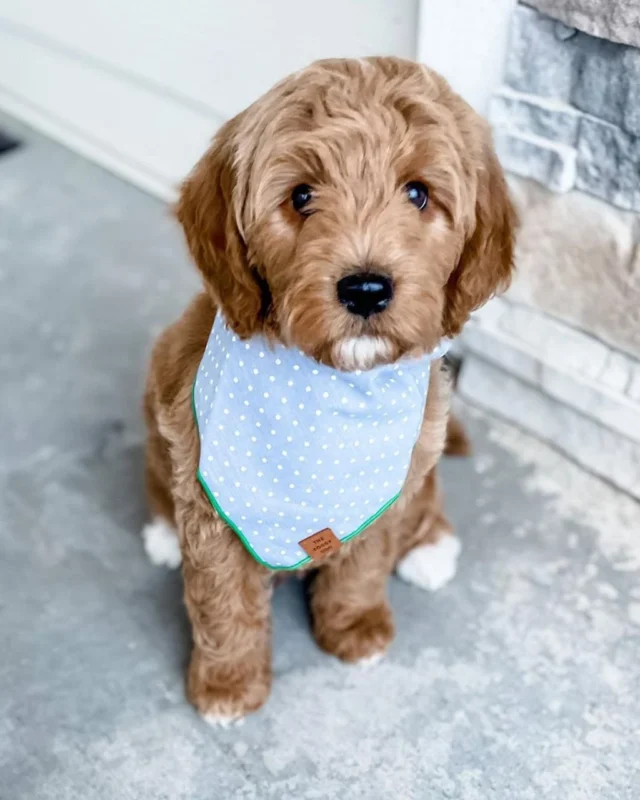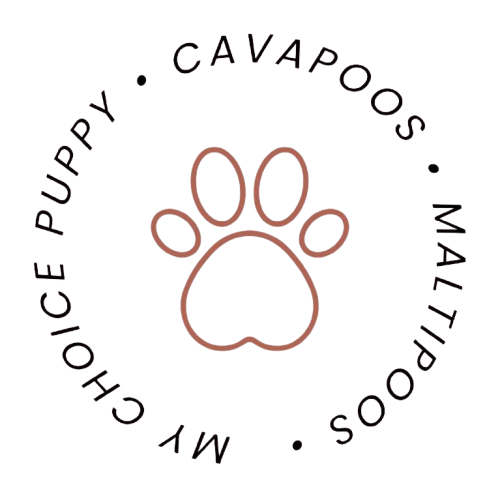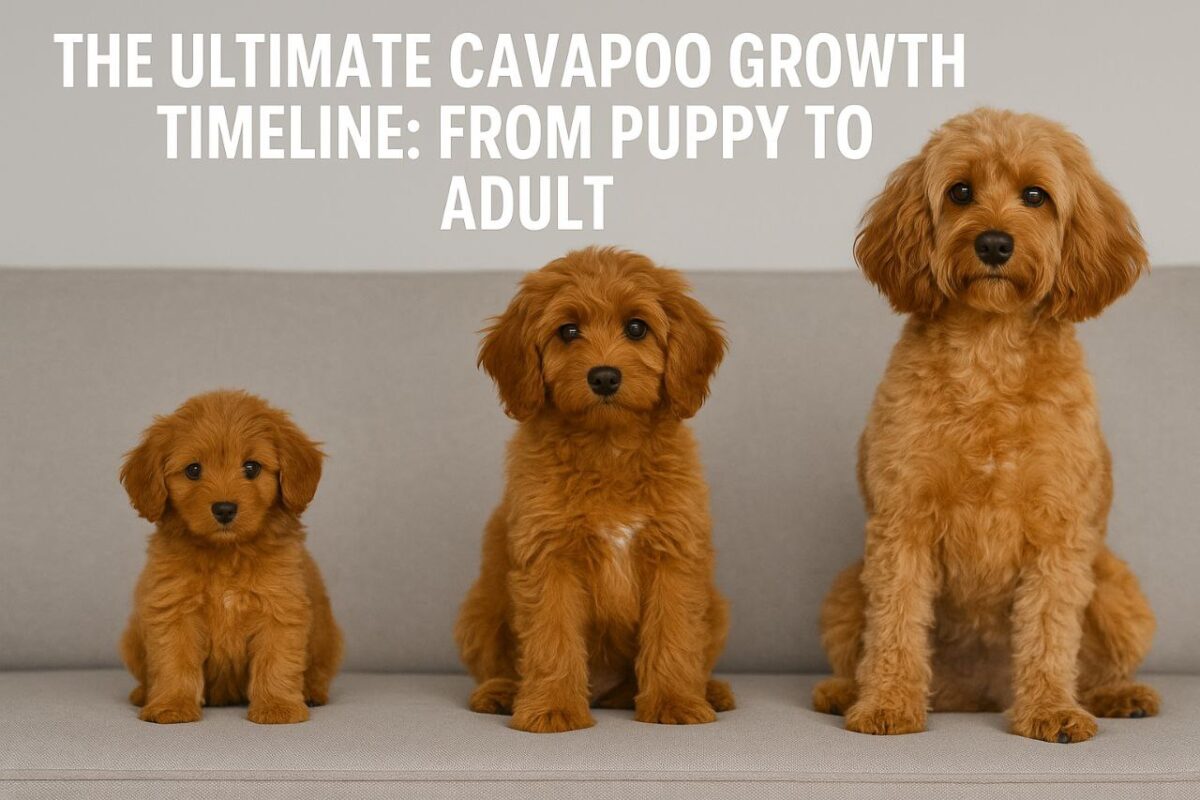Cavapoos, the delightful crossbreed of a Cavalier King Charles Spaniel and a Poodle, are cherished for their fluffy coats, affectionate personalities, and intelligence, making them ideal companions for families and first-time owners. Navigating the Cavapoo growth timeline is crucial for providing optimal Cavapoo puppy care, ensuring your pet thrives through each development stage. From the fragile newborn phase to the confident adult years, this comprehensive guide details the Cavapoo growth timeline, covering physical growth, behavioral milestones, emotional needs, and health considerations. With in-depth Cavapoo training tips, Cavapoo health advice, and Cavapoo socialization strategies, you’ll be equipped to avoid common pitfalls and raise a healthy, happy Cavapoo.
Table of Contents
ToggleNewborn to 8 Weeks: The Neonatal and Early Socialization Phase
The Cavapoo growth timeline begins with the neonatal phase, where puppies are born weighing 8–12 ounces, blind, deaf, and entirely dependent on their mother for warmth, nutrition, and stimulation. Lasting about two weeks, this stage focuses on survival—puppies nurse frequently and sleep to conserve energy. By 3–4 weeks, their senses awaken, marking the start of early Cavapoo socialization. They begin interacting with littermates, learning bite inhibition through play and developing basic social skills, foundational for the Cavapoo growth timeline.





Role of the Breeder
Breeders are pivotal in this phase, providing early stimulation to shape Cavapoo development stages. They introduce gentle handling, varied textures (e.g., soft blankets, rubber mats), and mild household noises like vacuums or music to build confidence. For example, a breeder might place puppies on a textured surface for a few minutes daily to stimulate sensory development. Health checks, including deworming and initial vaccinations (e.g., distemper at 6–8 weeks), are critical to ensure puppies are healthy before adoption, typically at 8 weeks when they weigh 2–5 pounds (toy Cavapoos smaller, miniatures slightly larger).
Preparing for Adoption
To support this stage of the Cavapoo growth timeline, choose a reputable breeder who prioritizes early Cavapoo socialization and health. Ask about exposure to stimuli and veterinary care records. Before bringing your Cavapoo home, prepare a puppy-safe space with a crate, chew toys, a cozy bed, and absorbent puppy pads for house training. Avoid adopting before 8 weeks, as premature separation can lead to emotional and behavioral issues, undermining Cavapoo puppy care. Schedule a vet visit within 48 hours of adoption to confirm health and continue vaccinations, setting the stage for a smooth transition.

8 Weeks to 6 Months: The Puppy Phase
The puppy phase, from 8 weeks to 6 months, is a vibrant period in the Cavapoo growth timeline, characterized by rapid physical growth, boundless energy, and a critical window for learning. Cavapoos grow to 6–12 pounds and 8–14 inches by 6 months, with toy Cavapoos at the lower end and miniatures slightly taller. Their coat evolves from soft puppy fluff to a denser, curlier texture, demanding diligent Cavapoo puppy care to prevent matting.
Physical Development
Puppies experience significant growth spurts, gaining muscle and bone density. Around 4–6 months, their adult teeth emerge, causing teething discomfort. Provide safe chew toys, like rubber bones or frozen carrots, to soothe gums and prevent chewing on furniture. Exercise needs increase to 30–45 minutes daily, split into short sessions to avoid overexertion. For instance, a 15-minute morning walk and a 20-minute evening play session with a ball in a fenced yard suffice. Feed a high-quality puppy food for small breeds, with 1/2 to 3/4 cup daily across three meals, adjusting based on weight and activity level to prevent obesity, a key Cavapoo health concern.
Behavioral and Training Milestones
This phase is pivotal for Cavapoo training tips, as puppies are highly receptive. Begin house training immediately, taking them out every 2–3 hours (after meals, naps, and play) and rewarding successful potty breaks with treats or praise. For example, use a cue like “go potty” and reward with a small treat to reinforce the behavior. Teach basic commands—“sit,” “stay,” “come,” and “down”—in 5–10-minute sessions twice daily, using positive reinforcement. To teach “sit,” hold a treat above their nose, move it back until they sit, and reward instantly. Consistency is crucial; enforce rules like no jumping on furniture every time to avoid confusion.
Enroll in a puppy obedience class to enhance Cavapoo training tips and provide structured socialization. These classes teach commands and expose puppies to other dogs, reducing fearfulness. Cavapoo socialization is critical during the 8–16-week window—introduce them to diverse people (e.g., children, delivery workers), animals, and environments like parks or pet stores. Before full vaccinations, carry them to avoid disease exposure, letting them observe from a safe distance. Pair new experiences, like car rides or doorbells, with treats to create positive associations, ensuring a confident puppy.
Health Considerations
Schedule vet visits every 3–4 weeks for vaccinations (e.g., parvovirus, rabies) and deworming, typically completed by 16 weeks. Start flea, tick, and heartworm prevention, and discuss spaying or neutering, often recommended at 5–6 months to reduce risks like mammary tumors. Cavapoos are prone to ear infections due to floppy ears, so clean weekly with a vet-approved solution, checking for redness or odor. Monitor for signs of allergies, like excessive scratching, which may require dietary adjustments. These Cavapoo health practices are essential for a thriving puppy.
6 Months to 1 Year: The Adolescent Phase
The adolescent phase, from 6 months to 1 year, is a transitional stage in the Cavapoo growth timeline, where physical growth slows, but behavioral and emotional development peaks. Cavapoos reach 80–90% of their adult size (10–20 pounds, 10–15 inches), with toy Cavapoos smaller and miniatures larger. Their coat fully develops, requiring consistent Cavapoo puppy care to maintain its health and appearance.

Physical and Nutritional Needs
Adolescent Cavapoos need 45–60 minutes of daily exercise to channel their high energy, combining activities like brisk 20-minute walks, fetch, or agility games in a dog park. For example, a morning walk followed by a 30-minute play session with a frisbee keeps them fit. Transition to adult dog food around 10–12 months, reducing to two meals daily (1/2 to 1 cup total), ensuring real meat is the first ingredient. Avoid overfeeding, as Cavapoos are prone to weight gain, which can exacerbate joint issues like patellar luxation. Regularly check their body condition—you should feel their ribs with slight pressure but not see them prominently.
Behavioral Challenges and Training
Adolescence brings testing behaviors, such as selective listening or stubbornness, as Cavapoos explore independence. Reinforce Cavapoo training tips with consistent commands and rules. For instance, if your Cavapoo ignores “come” in a park, practice in a low-distraction area with a long leash, rewarding compliance. Introduce advanced tricks, like “roll over” or “fetch specific toys,” to keep their mind engaged. Address separation anxiety, common in Cavapoos, by leaving them alone for 10–30 minutes with a treat-filled puzzle toy, gradually increasing duration. If destructive chewing persists, provide durable toys like KONGs and redirect attention.
Continue Cavapoo socialization by exposing them to new settings, such as busy streets or pet-friendly stores, to maintain adaptability. Regular playdates with other dogs prevent territorial behaviors, supporting Cavapoo development stages. If behaviors like excessive barking emerge, identify triggers (e.g., strangers) and desensitize them by rewarding calm responses.
Health and Grooming
Annual vet check-ups are essential to monitor Cavapoo health, including heart (for mitral valve disease), joints (for hip dysplasia), and eyes (for progressive retinal atrophy). Maintain dental care with daily brushing using dog-safe toothpaste, as small breeds are prone to plaque buildup. Cavapoo grooming involves brushing four to five times weekly with a slicker brush, focusing on matting-prone areas like the belly and legs. Bathe every 4–6 weeks, and schedule professional trims every 6–8 weeks to keep the coat manageable. Check nails monthly, trimming to prevent discomfort, and clean ears weekly to avoid infections.
1 Year to 2 Years: The Young Adult Phase
By 1 year, Cavapoos enter the young adult phase of the Cavapoo growth timeline, reaching full physical maturity at 10–20 pounds and 10–15 inches. Their personality solidifies, blending playfulness with a calmer demeanor, though they remain energetic and affectionate, requiring ongoing Cavapoo puppy care.

Physical Maintenance
Young adult Cavapoos need 45–60 minutes of daily exercise, combining physical activities like 25-minute walks or fetch with mental stimulation, such as puzzle toys or scent games. For example, hide treats in a snuffle mat to engage their intelligence, or set up an indoor obstacle course on rainy days. Feed 1/2 to 1 cup of adult dog food daily, split into two meals, and limit treats to 10% of calories to prevent obesity. Regular weight checks ensure they stay within a healthy range, reducing strain on joints and organs.
Behavioral Refinement
Reinforce Cavapoo training tips to maintain obedience in distracting environments, like practicing “stay” near a busy park. Address specific issues, such as jumping on guests, by redirecting to a “sit” command and rewarding compliance. Continue Cavapoo socialization through regular outings to dog-friendly cafes or hiking trails to keep them sociable. If separation anxiety persists, work with a behaviorist to develop a plan, such as leaving calming music or a worn shirt with your scent during absences.
Health and Long-Term Care
Annual vet visits monitor Cavapoo health, focusing on heart, joints, and dental conditions. Maintain daily tooth brushing and schedule professional cleanings every 1–2 years. Cavapoo grooming remains critical—brush four to five times weekly, bathe monthly, and schedule professional trims to prevent matting. Check for skin allergies or lumps during grooming, consulting your vet if abnormalities appear. These practices ensure long-term Cavapoo health and comfort.
2 Years and Beyond: The Adult Phase
The adult phase, starting at 2 years, marks the final stage of the Cavapoo growth timeline, where Cavapoos settle into their full personality—affectionate, intelligent, and adaptable. They maintain their adult size (10–20 pounds) and can live 12–15 years with proper Cavapoo puppy care.
Ongoing Care Needs
Adult Cavapoos need 45–60 minutes of daily exercise, adjusted for age or health conditions. Older Cavapoos may prefer shorter, gentler walks (e.g., 15-minute strolls twice daily), while younger adults enjoy agility courses or fetch. Continue feeding high-quality adult dog food, monitoring portions to prevent weight gain. Provide mental stimulation through training refreshers, like teaching “spin” or “high-five,” or using interactive toys to keep their mind sharp.
Health Monitoring
Regular vet check-ups (annually or biannually for seniors) are vital to detect age-related conditions like arthritis or dental disease. Watch for signs of stiffness, reluctance to jump, or changes in appetite, adjusting their environment (e.g., adding ramps) to support mobility. Maintain Cavapoo grooming with weekly brushing, monthly baths, and professional trims every 6–8 weeks. Monitor ears, skin, and nails, addressing issues promptly to ensure Cavapoo health.
Behavioral Stability
Adult Cavapoos are typically well-behaved if trained consistently. Periodically reinforce Cavapoo training tips, especially in new situations, to maintain obedience. Continue Cavapoo socialization through regular interactions with people and dogs to prevent shyness. If behavioral issues arise, like sudden aggression, consult a trainer to identify triggers and develop solutions.
FAQs About the Cavapoo Growth Timeline
Q: When do Cavapoos reach adulthood in the Cavapoo growth timeline?
A: Cavapoos reach physical adulthood around 1–2 years, with full behavioral maturity by 2 years, depending on Cavapoo development stages.
Q: How much should I feed my Cavapoo puppy?
A: Feed 1/2 to 3/4 cup of high-quality puppy food daily, split into three meals, adjusting based on Cavapoo puppy care needs and vet advice.
Q: What are key Cavapoo training tips for puppies?
A: Use positive reinforcement, keep sessions short (5–10 minutes), and maintain consistency with commands to support the Cavapoo growth timeline.
Q: How can I socialize my Cavapoo safely?
A: Before vaccinations, carry your puppy to safe spaces, arrange playdates with vaccinated dogs, and expose them to sounds for Cavapoo socialization.
Q: How often should I groom my Cavapoo?
A: Brush four to five times weekly, bathe every 4–6 weeks, and schedule professional grooming every 6–8 weeks to maintain Cavapoo health.
Q: What health issues should I watch for in the Cavapoo growth timeline?
A: Monitor for mitral valve disease, hip dysplasia, patellar luxation, and dental issues, with regular vet visits to ensure Cavapoo health.
Q: How much exercise does a Cavapoo need?
A: Provide 45–60 minutes daily, combining walks, play, and mental stimulation, tailored to their age in the Cavapoo growth timeline.
Q: Can Cavapoos develop separation anxiety?
A: Yes, Cavapoos are prone to separation anxiety. Gradually increase alone time with toys to support Cavapoo puppy care and prevent issues.
Conclusion
The Cavapoo growth timeline from puppy to adult is a rewarding journey filled with milestones that shape your pet’s physical, behavioral, and emotional development. By mastering Cavapoo puppy care, including consistent Cavapoo training tips, thorough Cavapoo socialization, and proactive Cavapoo health practices, you ensure your Cavapoo thrives at every stage. From neonatal care to adult maintenance, this guide equips you with the knowledge to raise a confident, healthy, and joyful Cavapoo, strengthening your bond for a lifetime of companionship. If you are ready to bring one of these adorable pups into your home, be sure to check out our Cavapoo for sale page for a list of our currently available puppies.

